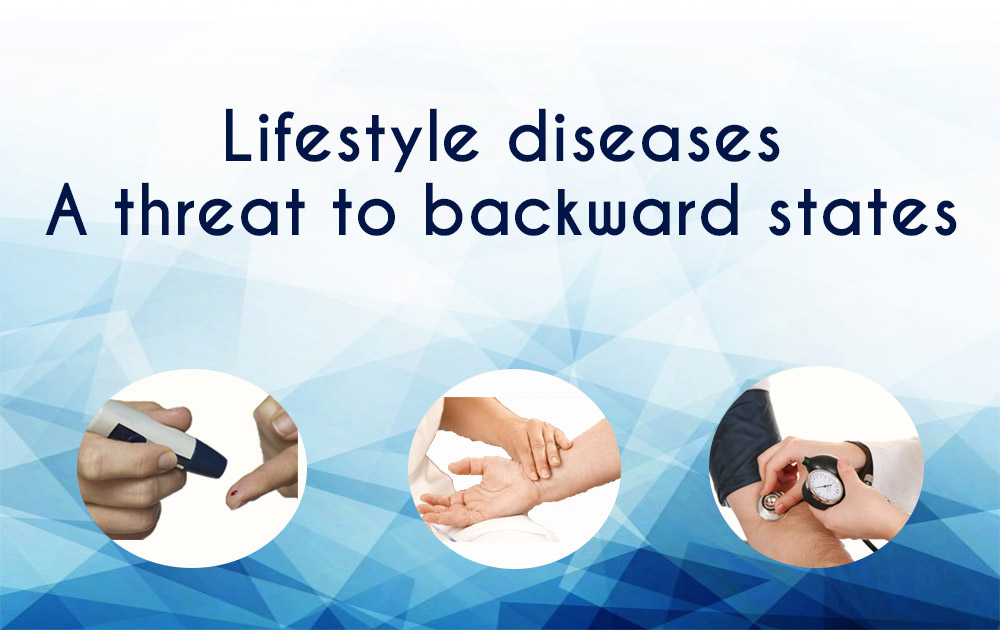Lifestyle diseases like chronic respiratory and heart diseases are killing more people in India than communicable ailments like Tuberculosis (TB) or Diarrhea in every states, including most backward belts, says the India State-Level Disease Burden Initiative’s Report.
Among the leading non-communicable diseases, the largest disease burden or Disability-Adjusted Life Year (DALY) rate increase from the period of 1990 to 2016 was observed for diabetes at 80 per cent, and ischaemic heart disease at 34 per cent.
In 2016, three of the five leading individual causes of disease burden in India were non-communicable, with ischaemic heart disease and chronic obstructive pulmonary disease as the top two causes and stroke as the fifth leading cause. The range of disease burden or DALY rate among the states in 2016 was nine-fold for ischaemic heart disease, four-fold for chronic obstructive pulmonary disease, and six-fold for stroke, and fourfold for diabetes across the country.
The key metric used in the study is DALYs, which is the sum of the number of years of life lost due to premature death and a weighted measure of the years lived with disability due to a disease or injury. The use of DALYs to track disease burden is recommended by India’s National Health Policy of 2017.
While ischaemic heart disease and diabetes generally had higher DALY rates in states that are at a more advanced epidemiological transition stage toward non-communicable diseases, the DALY rates of chronic obstructive pulmonary disease were generally higher in the Empowered Action Group (EAG) states that are at a relatively less advanced epidemiological transition stage.
The report shows that communicable diseases constitute almost two-thirds of the disease burden in India from a little over a third in 1990. Despite the transition, which is associated with development, malnutrition remains the single top risk for health loss.
All states have thus made what’s called the ‘epidemiological transition’ there remain wide variations in their disease profiles with some having made that transition as early as 1986, and others as recently as 2010.
The first group to make the transition in 1986 included Kerala, Tamil Nadu, Goa, Himachal Pradesh and Punjab. The last group to do so, accounting for the highest number of people (588 million), made the transition almost a quarter of a century later, in 2010. This group included Bihar, Uttar Pradesh, Madhya Pradesh, Chhattisgarh, Jharkhand, Rajasthan and Odisha. India as a country made the transition in 2003.
The Report’s executive summary says with almost one-fifth of the world’s population living in India, the health status and the drivers of health loss are expected to vary between different parts of the country and between the states.
Accordingly, effective efforts to improve population health in each state require systematic knowledge of the local health status and trends. While state-level trends for some important health indicators have been available in India, a comprehensive assessment of the diseases causing the most premature deaths and disability in each state, the risk factors responsible for this burden, and their time trends have not been available in a single standardised framework.
The Report finds that the Health status improving, but major inequalities between states Life expectancy at birth improved in India from 59.7 years in 1990 to 70.3 years in 2016 for females, and from 58.3 years to 66.9 years for males.
There were, however, continuing inequalities between states, with a range of 66.8 years in Uttar Pradesh to 78.7 years in Kerala for females, and from 63.6 years in Assam to 73.8 years in Kerala for males in 2016.
The per person disease burden measured as DALYs rate dropped by 36% from 1990 to 2016 in India, after adjusting for the changes in the population age structure during this period. But there was an almost two-fold difference in this disease burden rate between the states in 2016, with Assam, Uttar Pradesh, and Chhattisgarh having the highest rates, and Kerala and Goa the lowest rates.
While the disease burden rate in India has improved since 1990, it was 72% higher per person than in Sri Lanka or China in 2016. The under-5 mortality rate has reduced substantially from 1990 in all states, but there was a four-fold difference in this rate between the highest in Assam and Uttar Pradesh as compared with the lowest in Kerala in 2016, highlighting the vast health inequalities between the states.
Large differences between states in the changing disease profile of the total disease burden in India measured as DALYs, 61% was due to communicable, maternal, neonatal, and nutritional diseases (termed infectious and associated diseases in this summary for simplicity) in 1990, which dropped to 33% in 2016. There was a corresponding increase in the contribution of non-communicable diseases from 30% of the total disease burden in 1990 to 55% in 2016, and of injuries 18 %.
Want to write for InnoHEALTH? send us your article at magazine@innovatiocuris.com

